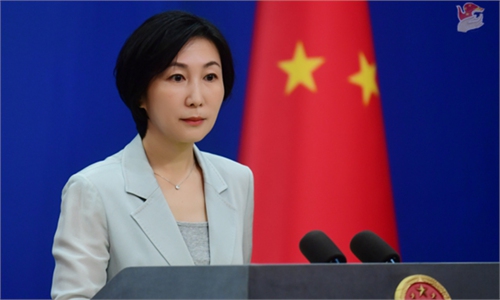
The Lancang River Photo:VCG
The eighth Greater Mekong Subregion (GMS) Summit is being held from Wednesday to Thursday in Kunming, Southwest China's Yunnan Province. The leaders of China and the other five Mekong countries, including Cambodia, Laos, Myanmar, Thailand and Vietnam, as well as the President of the Asian Development Bank (ADB), have had in-depth exchanges on the theme of "Toward a Better Community Through Innovation-driven Development." The GMS Summit, held once every three years, is the highest decision-making body for CMS economic cooperation. According to the Chinese Ministry of Foreign Affairs earlier, through this summit, China hopes to have in-depth exchanges with other parties, with emphasis on openness, innovation, connectivity and coordination, strive for new progress in cooperation in key areas including regional connectivity, trade and investment, agriculture and poverty alleviation, and make greater contributions to promoting sustainable development and economic integration in the region.The GMS is geographically important as it lies at the nexus of Southeast Asia, South Asia and China's greater Southwestern region. Running through the subregion, the Mekong River, known as the Lancang River in China, is an important international river in Asia. The region is rich in water, biological and mineral resources, with huge economic potential and development prospects. The GMS Economic Cooperation Program was initiated by the ADB in 1992 with the aim of promoting the economic and social development of the subregion by strengthening economic ties among member countries. Over the past 30 years, with the joint efforts of the six GMS member countries - China, Cambodia, Laos, Myanmar, Thailand and Vietnam - as well as the ADB, the program has been actively promoting synergistic economic and social development and regional integration, which has brought tangible benefits to the peoples of the six countries.
The GMS shares close geographical ties, strong people-to-people connections, and cultural affinity. Given the abundance of resources, large population, and immense market potential, there is a shared consensus among the nations to work together for mutual development.
In recent years, the region has advanced both "hard" infrastructure connectivity and "soft" alignment of rules and regulations, continuously enhancing connectivity. Since the beginning of this year, the China-Laos Railway, an important regional transportation hub, has transported over 16 million passenger trips and more than 16 million tons of cargo. In the two years since the operation of the Phnom Penh-Sihanoukville Expressway, a flagship project of China-Cambodia cooperation under the Belt and Road Initiative, the number of users has surpassed 10 million, contributing significantly to local employment, regional development, and public well-being.
Since its trial launch in June, the GMS cross-border road transport initiative has enabled cross-border transportation within the region without the need for vehicle changes or container opening, facilitating efficient logistics. The launch and operation of the Beijing-Yunnan-Lancang-Mekong Railway Express has significantly reduced the transportation time and costs for other countries to sell their products to the Chinese mainland. These efforts to improve the flow of goods, capital, technology, and people have strengthened the convenience, friendship, and deep integration among neighboring nations and close partners.
China has attached great importance to participating in the GMS economic cooperation, continuously promoting friendly relations with countries in the subregion. It adheres to the principle of not forming closed and exclusive small circles, maintains the correct direction of regional economic integration, and vigorously promotes the coordinated development of regional mechanisms. Its aim is to create a harmonious home that is open, inclusive, and characterized by mutual exchange and learning. The Lancang-Mekong Cooperation (LMC), initiated by China, is the first new sub-regional cooperation mechanism focused on building a community with a shared future with wide consultation, joint contribution and shared benefits of the six Lancang-Mekong countries. Since its inception, it has embodied the Lancang-Mekong spirit of development first, equal consultation, practicality and high efficiency, and openness and inclusiveness while promoting an LMC culture featuring equality, sincerity, mutual assistance and kinship. It has consistently sought cooperation and wholeheartedly promoted development, leading to continuous improvement and upgrading of LMC.
In the first half of this year, the total trade volume between China and the Mekong countries exceeded $200 billion, a year-on-year increase of 12 percent, with China continuing to be the largest trading partner of the Mekong countries.
Over the past year, visa exemption policies between China and Thailand, as well as between China and Laos, have been implemented successively, and the China-Cambodia people-to-people exchange year has been successfully launched. At the same time, events such as the Lancang-Mekong Audiovisual Week, Youth Innovation Competition on Lancang-Mekong Region's Governance and Development, and the Lancang-Mekong Young Entrepreneurs Forum have been successfully held. The Lancang-Mekong Tourist Cities Cooperation Alliance is set to play a larger role.
The Lancang-Mekong River begins its journey in the Tanggula Mountains, gathering countless tributaries as it flows southward, nourishing the peoples of the countries in the region. The GMS cooperation, much like this great river, brings together the aspirations of the people along its banks for prosperous development, forming a torrent of shared destiny and collaborative efforts. With the support of mechanisms such as the GMS economic cooperation, the future potential is limitless.


